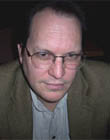|
|
 
|
|
Author
|
Topic: Mixed Optical Formats
|
|
|
Leo Enticknap
Film God

Posts: 7474
From: Loma Linda, CA
Registered: Jul 2000
|
 posted 05-05-2014 08:40 PM
posted 05-05-2014 08:40 PM





My guess is that the final scene involved some complicated mixing down of multiple channels, and that this was outsourced to a post house that used a VA sound camera to produce the final negative; but that the rest of the movie was recorded in-house on VD equipment.
The movie was made in 1949, just before mag film and/or tape became the widespread norm for original recording and mixing in post-production (i.e. the production workflow evolved to the point at which "burning out" the optical track neg was the very final step, and the only one in which optical technology was used).
It was made by TC-F, which was a Western Electric (i.e. VD) studio. So RCA (VA) technology was probably used in the mixing of that one scene for a specific reason. VA was much more resilient to duplication through subsequent generations - in particular, poor timing or densitometry control in the lab could really screw up the gain and headroom on VD tracks. So if there was complicated mixing to be done, it makes sense that the production company and/or the post house involved might have bitten the bullet, paid RCA the eyewatering licensing fees they charged for the use of their optical sound technology (in Britain it was £20 per 1,000 foot reel of release print (598 UK pounds in 2012 adjusted for inflation, so around USD $1k - I'm guessing that their US licensing fees would have been similar) just for that one scene, but not paid for the better technology in the rest of the movie, where they didn't need it.
| IP: Logged
|
|
|
|
|
|
Leo Enticknap
Film God

Posts: 7474
From: Loma Linda, CA
Registered: Jul 2000
|
 posted 05-06-2014 10:50 AM
posted 05-06-2014 10:50 AM





And VD was far more susceptible than VA.
In some ways, the difference between state-of-the-art VA (which means RCA Duplex during the period we're talking about) and VD is similar to the difference between an audiophile LP and an average CD. When it was good, VD could sound very good; but it required much better quality control in the lab, and depended on a totally clean power supply to the exciter lamp in the projector and critical tolerances in the slit azimuth. If either of these slipped below spec (e.g. slight overexposure or underdevelopment of the print, or a tiny amount of AC leakage into the exciter) it sounded shyte. Because, as its name suggested, VD used differences in density between two fixed points on the film surface to encode the modulation of the signal, that difference needed to be recorded and read accurately for the system to work. VA, on the other hand, measured where that difference in density was placed on the film, not how big or small the actual difference itself was. The lateral alignment of the photocell in the projector was more critical, but the other factors much less so.
The reason why Western Electric and the studios that were aligned to them stuck with VD recording and mastering throughout the '30s and '40s was patents and money, basically: RCA had the superior technology and charged top dollar for it.
| IP: Logged
|
|
|
|
Richard P. May
Expert Film Handler
Posts: 243
From: Los Angeles, CA
Registered: Jan 2006
|
 posted 05-06-2014 05:48 PM
posted 05-06-2014 05:48 PM




Starting in the late 1930s Warner Bros. was combining variable area and variable density optical tracks to control volume in the theatre. Doing preservation work on a 1938 short subject, CAPTAIN OF THE GUARD, I think. I noticed the original track negative used density for dialog scenes, and area for musical numbers.
Recently, for a Hollywood SMPTE meeting about special effects, we borrowed a preservation print of SPAWN OF THE NORTH (Paramount, Academy Award winner for special effects in 1938) from its current owner, Universal. In preparing the print to use a section of the big iceberg sequence, I noticed the one reel carried three different kinds of optical track: density for dialog, unilateral area for moderate action, and duplex area for the big crash of the icebergs. This reproduced extremely well on a modern sound system.
This was so the production company could control the theater sound volume by making tracks that would transmit different amounts of light to the photo pickup cell.
It is easy to imagine why Fox would have used a similar technique for a picture like 12 O'CLOCK HIGH, with a lot of dialog, but some very loud airplane battle sequences.
Also, WB's sound department received a technical Academy Award in, I think, 1937 for combining density and area tracks.
| IP: Logged
|
|
|
|
All times are Central (GMT -6:00)
|
|
Powered by Infopop Corporation
UBB.classicTM
6.3.1.2
The Film-Tech Forums are designed for various members related to the cinema industry to express their opinions, viewpoints and testimonials on various products, services and events based upon speculation, personal knowledge and factual information through use, therefore all views represented here allow no liability upon the publishers of this web site and the owners of said views assume no liability for any ill will resulting from these postings. The posts made here are for educational as well as entertainment purposes and as such anyone viewing this portion of the website must accept these views as statements of the author of that opinion
and agrees to release the authors from any and all liability.
|

 Home
Home
 Products
Products
 Store
Store
 Forum
Forum
 Warehouse
Warehouse
 Contact Us
Contact Us




 Printer-friendly view of this topic
Printer-friendly view of this topic












